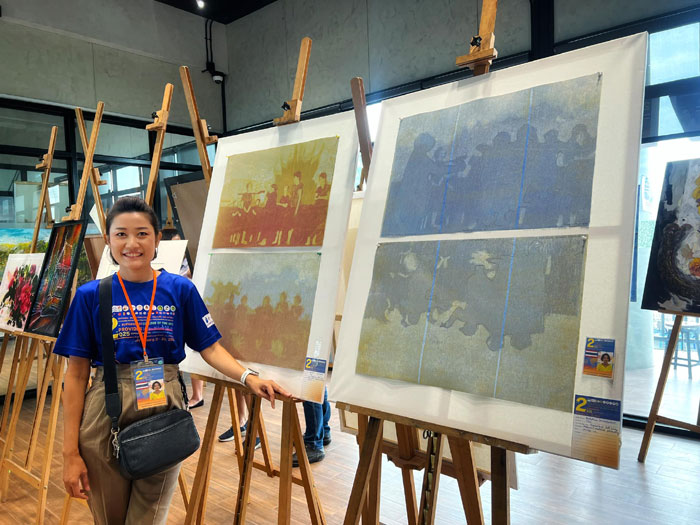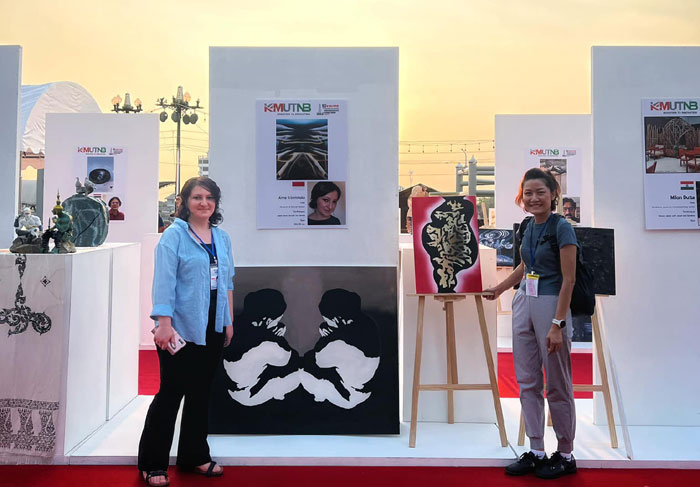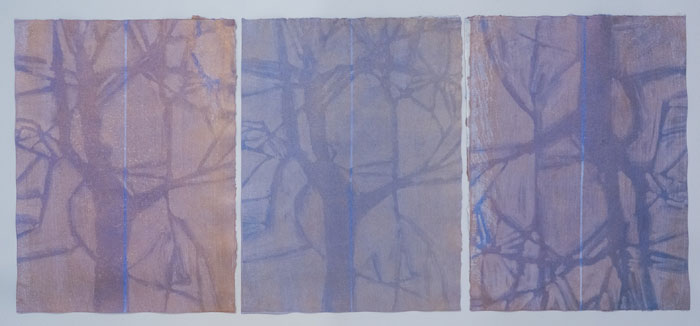|
I met Nophaklo Srimatyakun at CMU Art & Culture Center. At that time, she came to WMW, the CMU 60th anniversary World Master's Watercolor Exposition to present her work and to organize the World Master Water color exhibition as a host.
At the beginning of
January 2025 weather
was very good in
ChiangMai, flowers
bloom like springtime
and many visitors from
institutions in many
parts of Thailand had
appointments to see the
water-color paintings
We had a chance to
interview about her
work and her life, She
is the one who had Solo
Exhibition every year.
It was a great
opportunity to get to
know her more.
She is a lecturer in
the Department of
Printmaking, Department
of Visual Arts, Faculty
of Fine Arts, Chiang
Mai University. Her
specialty is watercolor
woodcut printmaking,
which is her forte. She
also studies natural
materials that can be
used to create artwork
without harming the
environment as much as
possible.
She wants to instill in
the younger generation
the value of the
environment and learn
how to create artwork
without harming the
environment, which is
an approach she wants
to further study and
instill in the younger
generation so that they
will realize and see
its value.

JY.
"What inspired you to study and pursue a career in printing?
Are there any specific mentors or experiences that shaped your
career path?"
NS
. From my childhood interests, I remember that I really liked
drawing when I was a child. I liked doing handicrafts and crafts.
Since I was a child, I would always represent my school in various
painting competitions. When I started high school, I chose to join
the art club. I used all my free time as a child to do art, do club
activities, sometimes I submitted to competitions, sometimes I
won, sometimes I didn't. I didn't expect to choose it as a career,
but I was happy doing it. During my childhood, I liked to create
works that presented ideas in a comparative way to convey the
meaning of what I wanted to tell, more than drawing realistic
pictures. My art teacher in junior high school saw that I was
determined to work in art, so he recommended that I study art
directly at the vocational certificate level at Rajamangala
University of Technology to prepare for the university entrance
exam for art at the bachelor's degree level. At that time, university
entrance exams were still an entrance system. You could choose 2
-3 levels. I chose Silpakorn University as my first choice and
Chiang Mai University as my second choice. When the exam
results came out, it turned out that I was accepted to Chiang Mai
University. I traveled from my hometown in Nakhon Ratchasima
Province (in the northeastern region of Thailand) to study for my
bachelor's degree at Chiang Mai university. It was the first time I
had to move to another city for five years. I didn't know anyone, I
didn't have any relatives, and I had to get to know my friends.
There were very few places to visit in the city. When I went out
with my friends, I would invite them to go up the mountain to see
the forest, the mountains, and the way of life of the hill tribes, the
Hmong, and the Meo. It was so much fun. I forgot all about the
bright lights at that time. The furthest I went was Central Pang
Suan Kaew and Kad Luang. After I finished studying, I went to
the studio to work on art, projects, and thesis. At that time, I
chose to do printmaking, using the woodcut printmaking
technique, because I liked the carving of the surface marks that
appeared in the work. It was something that really attracted me to
doing art. I liked Picasso's work and Van Gogh's work. I studied
the arrangement of the composition by the artist. As for the use of
color, I studied Monet's work. Children of art at that time liked
modern art and impressionist art. I tried to study and apply it to
create my own work. My early works were oil-based woodcut
prints. They had stories inspired by the landscapes of Chiang Mai,
the North, and almost all of the mountains. They focused on
presenting the impressions of the atmosphere, colors, and
shadows that I encountered during my stay and traveled to
various places. Throughout the 4-5 years that I studied at the
Faculty of Fine Arts, Chiang Mai University, after graduating with
a bachelor's degree, I went on to study for a master's degree and a
doctorate degree at Silpakorn University. The works during my
master's degree period began to change from an interest in the
landscape (the outside world) to an interest in the state of feeling
within my own mind (the inner world). This was the period when
I began to be interested in studying the practice of Vipassana
meditation. When I seriously studied and practiced meditation, I
saw the benefits to my life in many aspects. I became interested in
presenting the various states that occurred during the practice of
Vipassana meditation in my artwork. I thought of ways to create
artwork that connected the practice of Vipassana meditation with
the practice of art. The artists who inspired me during this period
were two Zen artists: Motoi Yamamoto and Wolfgang Laib.

Currently, I am a lecturer in the Department of Printmaking,
Department of Visual Arts, Faculty of Fine Arts, Chiang Mai
University. My specialty is watercolor woodcut printmaking,
which is my forte. I also study natural materials that can be used
to create artwork without harming the environment as much as
possible. I want to instill in the younger generation the value of
the environment and learn how to create artwork without
harming the environment, which is an approach I want to further
study and instill in the younger generation so that they will
realize and see its value.

JY
. What challenges have you faced as a woman in the field of
printmaking? How have those experiences influenced your art
form and career direction?
NS
. From talking to female artists, most female artists often face
challenging problems during the period when their lives have to
change status, when they have other responsibilities and roles in
their lives, such as having a family, having children, having
additional responsibilities, the role of mother, being a caretaker
of the house, sacrificing for the family often affects the serious
creation of artwork by female artists. Most female artists create
artwork as a hobby or to relax instead of seriously creating, and
most of them tend to be quite absent from the art world.
However, I personally think that another problem that they often
encounter may not be just a lack of time to continuously create
artwork. But it is a lack of opportunities to present their work to
society to make them aware of the existence of these female
artists. Presenting their work requires traveling both near and far,
sometimes traveling as far as foreign countries frequently, having
to participate in various art activities, which the difficulty for
women in traveling and living abroad is an important issue that
causes female artists to gradually decrease in the art industry.Due
to these factors, many female artists who continue to create art
are still seen as having a high risk of abandoning it halfway,
"unsustainable". If asked, "How do these experiences influence
the form of art or the direction of their careers?" The answer is
that the experiences in life, in every step of life, may not only be
as a female artist, but also in the role of a human being who must
have a path in life and create benefits for themselves and society
in various aspects. Throughout the path of life that has been
walked, there may be some problems, encounter some obstacles,
but all of life is a concept and inspiration that can always be
picked up to create art, in all forms and without limitations.
Personally, I think that the art that we create presents our
perspective of the world, of life, which is passed on through our
art. Sometimes, creating prints faces problems with techniques
that require chemicals. When we learn and want to live a good life
in order to continue creating art, choosing to use natural
techniques to replace the use of various chemicals. It is also a part
of the way of creating works that we choose to practice. Learning
and adapting the principles of Dharma and nature to become a
part of the principles of creating art until it becomes a way of life.
Everything arises from problems and problem-solving in order to
find common ground, balance, and moderation for living life,
working, pursuing a career, and creating art together.

JY
. Can you share some insights of your creative process? How
do you design and create new prints?
NS.
Most of my current artworks are watercolor woodblock
prints. The origin and concept behind each series of artworks
depend on my current interests. For example, my artworks in
2023 were inspired by local Lanna Thai weaving, while my
artworks in 2024 were inspired by the local handmade
papermaking in Lanna to apply to my own artworks. However,
despite the different origins of each piece, most of them are
created by combining the principles of meditation practice with
artistic practice.
In creating the molds for most of my artworks, I draw directly on
the molds. Sometimes I use a brush dipped in ink and swipe it
directly on the molds. Sometimes I use a pencil to sketch the
shadows of the originals, as in the series Balance: Body and
Breath. The series "Lanna Weaving" uses a brush to draw the
landscape in front of you directly onto the mold. The series
"Lanna Weaving" uses a mold to create shadows of woven objects
directly onto the wooden plate of the mold. The shadows are then
used to create molds for printing in the series.
In the process of watercolor woodblock printing, after creating
the mold, the part of the mold that you don't want the ink
(watercolor) to stick to the mold will be covered with lacquer.
Then, the mold will be printed with water color on the moist
paper. In the process of creating this work, the creator often uses
this detailed and meticulous period of time along with
meditation, which is considered to be using every moment of
work and life to practice meditation, to practice Vipassana
meditation at the same time. Therefore, the practice of creating
art is like a way of practicing meditation at the same time, just
like waking up in the morning, washing your face, brushing your
teeth, eating, working, and creating art.

JY
. How do you balance your personal life with your professional
commitments in the world of printmaking?
NS
. Personally, I see art making as part of life. It is not divided
into what is work to earn money, what is personal life, or when to
do art, when to meditate. Everything is a way of life, every
component of life, a part of life. Everything is practice,
development, self-improvement, and cannot be separated. But we
cannot assume that it will always be like that. We just learn,
understand, and live in that role as best we can. This should be a
way to create balance for all of our roles and responsibilities. As
for my perspective on creating printmaking, I personally see
printmaking as not just printing images, but it is a way of
conveying life experiences. Stories that come in are often
conveyed through my own artwork, including the form of
creation that is considered in a meditative way, which is part of
the process of accumulating experiences, our perspective on
problems, our methods of solving problems that come in life.
These things, our artworks tend to reflect our attitudes towards
the world, our way of seeing the world. We see it as a form of self
-training that, when things come in, we consider and convey them
as artwork, along with self-reflection. Making art is like a process
of training yourself. Consider yourself. It is part of each other. It
cannot be separated.

JY
. What message or impact do you hope your prints will leave
for future artists, especially women?
NS
. Creating art is a way of life. It is a way of polishing yourself
through work. If we do not see it as a burden, we must have time,
space, a studio, and equipment. Many limitations will discourage
us and make us not want to start working. But if we see making
art as a part of it, a way of life, like eating, washing dishes, living,
it will be a part of our lives that we must do simply and normally.
It is a part of our practice. We do not separate it from having time
to start working. It can be done all the time. We do not need a lot
of equipment or a complete studio. It can be done anywhere,
anytime. We just have to be open to learning and accepting its
way of life. Then it will be our way of life.
|